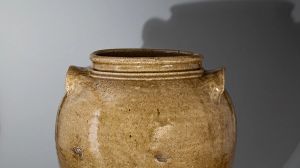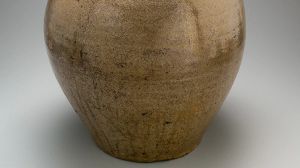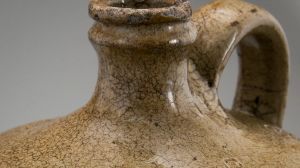
(2) Jar, attributed to David Drake, ca. 1850. Alkaline glazed stoneware. 15 ½ x 13 1/2". Courtesy William C. and Susan S. Mariner Private Foundation. Photo by Robert Hunter.
Overview
The two stoneware vessels on view, an early jug from the 1820s and a jar from around 1850, are exemplary of the Edgefield tradition, with their robust forms and distinctive alkaline glaze. They are attributed to David Drake, a master potter who produced thousands of vessels between the 1820s and 1860s while enslaved in South Carolina. He dated and signed his name to many of his wares, and at times included original verse. Though unsigned, these vessels bear the physical and historical weight of Drake’s legacy - his technical mastery, his resilience, and his singular voice. Whether inscribed with verse or subtly marked, his pots assert presence and personhood, resonating far beyond their original function.
2025 Exhibition Season
For its 2025 exhibition season, Tinworks Art presents A Kin to Clay, an exhibition that honors the rich legacy of ceramics in Montana while tracing its connections to broader histories and cultural lineages. Through the work of artists who engage clay and earthen materials as vessels of memory, resistance, and community, the exhibition explores how a shared relationship to the earth can shape meaning across generations and geographies.
About the Artist
David Drake, also known as “Dave the Potter, was a master potter and enslaved man who produced beautifully crafted and often massive coil-form storage vessels in Edgefield, South Carolina between the 1820s and 1860s. He is thought to have produced more than 40,000 works, although fewer than 270—signed or attributed—exist today. Many of these pots he inscribed with his name “Dave,” often dating the vessel, and at times included the name of his enslaver, single words, lines of original rhyming verse, references to Biblical passages, and marks representing the amount the vessel could hold. Drake is the only Black potter known to have signed and inscribed his work from among the dozens of enslaved people who labored in the pottery factories at Edgefield. He did so at a time when it was illegal for enslaved and free people of color in South Carolina to read or write. Drake’s work has become central to American ceramics history; his legacy has influenced generations of artists, including Theaster Gates, who has brought renewed attention to Drake’s work. The remarkable craftsmanship, authorship, lyricism and enduring presence of Dave’s pots stand in rebuke to the dehumanization central to the institution of slavery, and are a testament to endurance, creativity and the human will to be seen


